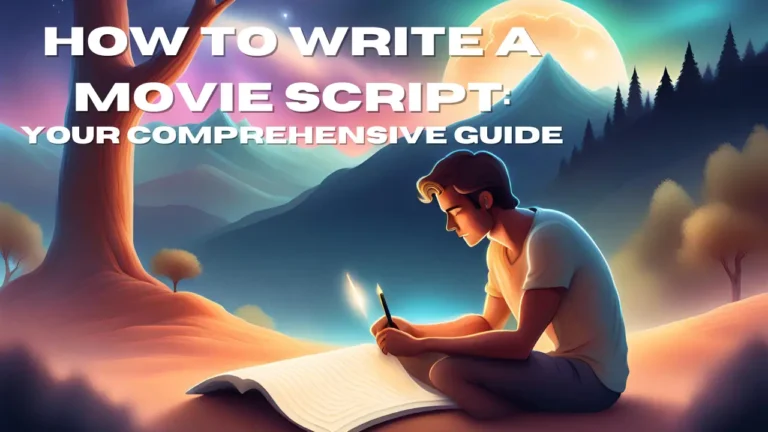Table of Contents
ToggleIn the world of cinema, the script is the backbone of any great film. It’s where the magic begins, and every memorable line, plot twist, and emotional moment is born. Whether you’re a budding screenwriter or simply curious about the craft, this guide will take you through the intricate process of how to write a movie script. From generating ideas to formatting and polishing your screenplay, we’ve got you covered in this comprehensive guide on how to write a movie script.
Related: Filmmaking 101: The Ultimate Guide to Narrative Filmmaking
How to Write a Movie Script in 15 Steps
So, you’ve decided to explore how to write a movie script, but where do you begin? Here’s a 15-step breakdown to guide you as you get started:
Generating Creative Ideas
The cornerstone of learning how to write a movie script lies in cultivating a distinctive and captivating idea. To generate creative ideas:
- Draw from Personal Experiences: Often, the most authentic and engaging stories come from your own life experiences, emotions, and observations. Think about personal moments that left a strong impression on you.
- Current Events and News: Current events, social issues, or news stories can be a rich source of inspiration. They can provide the backdrop for your story or even serve as the central theme.
- Read Widely: Reading books, articles, and other scripts can help you identify interesting themes, narrative techniques, or even gaps in storytelling that you can explore in your own script.
- Brainstorm with Others: Collaborating with friends or fellow writers through brainstorming sessions can lead to fresh and unexpected ideas.
Remember, the key is to find a concept that excites you and has the potential to resonate with your audience.
Understanding the Three-Act Structure
The three-act structure is a fundamental framework for organizing the narrative of your script. Here’s how it breaks down:
- Act 1: Setup: In the first act, you introduce your characters, setting, and the central conflict. This is where you grab the audience’s attention and set the stage for the story’s development.
- Act 2: Confrontation: Act two is the longest and most dynamic part of your script. It’s where you delve into the challenges and obstacles your characters face as they pursue their goals. This act is marked by rising tension and conflict.
- Act 3: Resolution: In the final act, you bring the story to a climax and resolve the central conflict. This is where you provide closure and leave a lasting impression on your audience.
Understanding this structure is crucial for crafting a compelling narrative in your journey of learning how to write a movie script. It ensures a seamless flow that captivates and retains the viewer’s interest.
Developing Engaging Characters
Characters are the heart of your script, and their development is crucial:
- Character Arcs: Characters should undergo growth or transformation throughout the story. This change can be emotional, psychological, or even physical.
- Flaws and Strengths: Well-rounded characters have both flaws and strengths. These human qualities make them relatable and interesting.
- Motivations: Understand what drives your characters. Their desires, fears, and goals shape their actions and decisions.
- Backstories: Even if not explicitly mentioned in the script, knowing your characters’ backgrounds helps you write consistent and believable dialogue and actions.
Crafting a Captivating Plot
A captivating plot keeps the audience engaged from start to finish:
- Conflict: Every script needs a central conflict or problem that the characters must address. This conflict creates tension and drives the story forward.
- Pacing: Balance action and quieter moments to maintain the audience’s interest. A well-paced script keeps viewers invested in the characters and their journey.
- Subplots: Subplots add depth to your story and can provide additional layers of tension, humor, or emotion.
- Twists and Turns: Don’t be afraid to surprise your audience with unexpected developments. Twists and turns can make your script memorable.
Mastering Dialogue
Dialogue is a powerful tool for character development and storytelling:
- Realistic Conversations: Dialogue should sound natural and reflect the way people speak. Listen to real conversations and pay attention to how people express themselves.
- Show, Don’t Tell: Instead of explicitly stating information, use dialogue to reveal character traits, emotions, and plot details through subtext.
- Conflict in Dialogue: Conflict-driven dialogue can be particularly engaging. Characters with opposing goals or viewpoints can create tension and drama.
- Character Voice: Each character should have a distinct voice and manner of speaking. This helps differentiate them and adds depth to your script.
Formatting Your Script
Proper formatting is essential for readability and industry acceptance:
- Industry Standards: Follow industry-standard formatting guidelines, such as those provided by the Writers Guild of America (WGA) or software like Final Draft. Consistency is key.
- Scene Headings: Clearly indicate where scenes take place with scene headings. Include INT. (interior) or EXT. (exterior) and location.
- Action Lines: Use action lines to describe character movements, expressions, and important visual details.
- Character Names and Dialogue: Place character names above dialogue and format dialogue with character names centered and in uppercase.
- Parentheticals: Use parentheticals sparingly to provide context for character dialogue.
Mastering these fundamentals of how to write a movie script lays the groundwork for a polished and expertly crafted screenplay.
Incorporating Visual Elements
Scripts aren’t just about words; they also include visual descriptions to guide directors and cinematographers:
- Scene Description: Use vivid and concise language to paint a picture of each scene. Describe the setting, lighting, and any important visual elements that contribute to the story.
- Camera Directions: While it’s generally best to avoid camera-specific instructions, you can suggest camera angles or movements when they are essential to the narrative.
- Visual Metaphors: Consider using visual metaphors or symbolism to convey emotions or themes visually.
Balancing descriptive visuals with engaging storytelling is pivotal in the process of learning how to write a movie script. It is the key to crafting a script that captures the imagination of both readers and filmmakers.
Polishing Your Script
Effective scriptwriting involves multiple rounds of editing and revision:
- Grammar and Spelling: Ensure your script is free of grammatical errors and spelling mistakes. Typos can be distracting and unprofessional.
- Consistency: Double-check character names, locations, and plot details for consistency throughout the script.
- Read Aloud: Read your script aloud or have someone else read it to identify awkward phrasing, pacing issues, or dialogue that doesn’t flow naturally.
- Trim Excess: Eliminate unnecessary scenes, dialogue, or descriptions. Keep the script concise and focused on advancing the story.
- Seek Feedback: Share your script with trusted peers, mentors, or scriptwriting groups for constructive feedback. Fresh perspectives can uncover blind spots.
Getting Feedback
Don’t hesitate to seek feedback from others throughout the scriptwriting process:
- Peer Review: Collaborate with other writers or aspiring filmmakers to exchange feedback on each other’s work. Constructive criticism helps you refine your script.
- Professional Feedback: Consider hiring a script consultant or taking part in scriptwriting workshops where experienced industry professionals can provide insights.
- Reader Feedback: If you’re planning to submit your script to competitions or production companies, gather feedback from script readers who can provide objective assessments.
Receiving feedback is a crucial aspect of mastering how to write a movie script. It plays a vital role in script development, aiding you in pinpointing areas for enhancement and fine-tuning your storytelling.
Preparing for Production
Understanding the pre-production process is vital for aspiring screenwriters:
- Pitching: Develop a compelling pitch for your script to attract producers or investors. Highlight the unique elements that make your story stand out.
- Securing Funding: Explore various avenues for funding your project, such as grants, investors, or crowdfunding campaigns.
- Assembling a Team: Collaborate with directors, producers, actors, and crew members who share your vision for the script.
- Legal Considerations: Familiarize yourself with legal aspects, including contracts, rights, and intellectual property to protect your work.
The pre-production phase is where your script takes its first steps toward becoming a realized film.
Navigating Legalities
Understanding the legal aspects of scriptwriting is crucial:
- Copyright Protection: Consider registering your script with the U.S. Copyright Office or the relevant authority in your country. This provides legal proof of ownership.
- Contracts: When working with others, ensure you have clear contracts in place, outlining rights, royalties, and responsibilities.
- Release Forms: If you use real people’s names or likenesses in your script, obtain their written permission to avoid legal issues.
Protecting your script legally ensures that your creative work remains secure as it moves through the filmmaking process.
Collaborating with Directors
Effective collaboration with directors and other creatives is essential for bringing your script to life:
- Open Communication: Maintain clear and open communication with the director, cinematographer, and production team to ensure your vision is understood.
- Flexibility: Be open to creative input and adaptations. Filmmaking is a collaborative process, and adjustments may be necessary.
- Trust: Trust the expertise of the professionals you’re working with while advocating for your script’s core vision.
Successful collaboration in the realm of learning how to write a movie script can result in a screenplay that not only mirrors your creative vision but also leverages the expertise of industry peers.
Adapting to Changes
Filmmaking is a dynamic and evolving process. Be prepared to adapt your script:
- Feedback Integration: Embrace feedback from the production team, actors, and test audiences. Adjust your script as needed to enhance the final product.
- Budget Constraints: Recognize that budget limitations may require script alterations. Finding creative solutions can help maintain the integrity of your story.
- Production Challenges: Unforeseen challenges during filming may necessitate script changes. Stay flexible and solution-oriented.
Adaptability is a valuable trait for anyone delving into the process of learning how to write a movie script. It ensures that your script can thrive in the dynamic and constantly evolving landscape of filmmaking.
Marketing Your Script
Once your script is ready, you’ll need to market it effectively:
- Query Letters: Write compelling query letters to agents, managers, and production companies to introduce your script.
- Pitch Sessions: Attend pitch sessions at industry events or online platforms to present your script to potential buyers.
- Networking: Build relationships with industry professionals through networking events, conferences, and social media.
- Online Presence: Create an online presence to showcase your work, including a professional website or portfolio.
Marketing your script is a crucial step in getting it noticed and potentially picked up for production.
Celebrating Successes
Every script you write is a significant achievement. Celebrate your successes along the way:
- Completing Drafts: Celebrate each draft you complete, as each one brings you closer to your final script.
- Recognition: Acknowledge any recognition your script receives, such as awards or positive feedback.
- Growth: Recognize your growth as a writer, even in the face of challenges and rejections.
Remember that the journey of mastering how to write a movie script holds as much significance as reaching your destination, and every step forward is a reason to celebrate.
Conclusion
Congratulations! You’ve now embarked on a journey to master the art of how to write a movie script. Remember that writing a movie script is a learning process, and every script you write brings you one step closer to your goals. Keep writing, refining your skills, and, most importantly, telling the stories that matter to you.
FAQs
What is the ideal length for a movie script?
A typical movie script ranges from 90 to 120 pages, with one page roughly equating to one minute of screen time.
Can I write a film script without any prior experience?
Absolutely! While experience helps, passion and dedication are equally important in learning how to write a movie script. Start with short scripts and gradually work your way up to larger projects.
Do I need expensive software to format my script?
No, there are many free and affordable scriptwriting software options available, such as Celtx and Trelby.
How can I protect my film script from plagiarism?
Register your script with the Writers Guild of America or a similar organization to establish a legal record of your work.
Should I stick to one genre or experiment with different genres?
While specialization can be beneficial, experimenting with various genres can broaden your skills and creativity.
What are some common mistakes to avoid in scriptwriting?
Avoid excessive dialogue, too much description, and overly complicated plots. Keep it concise and engaging.






